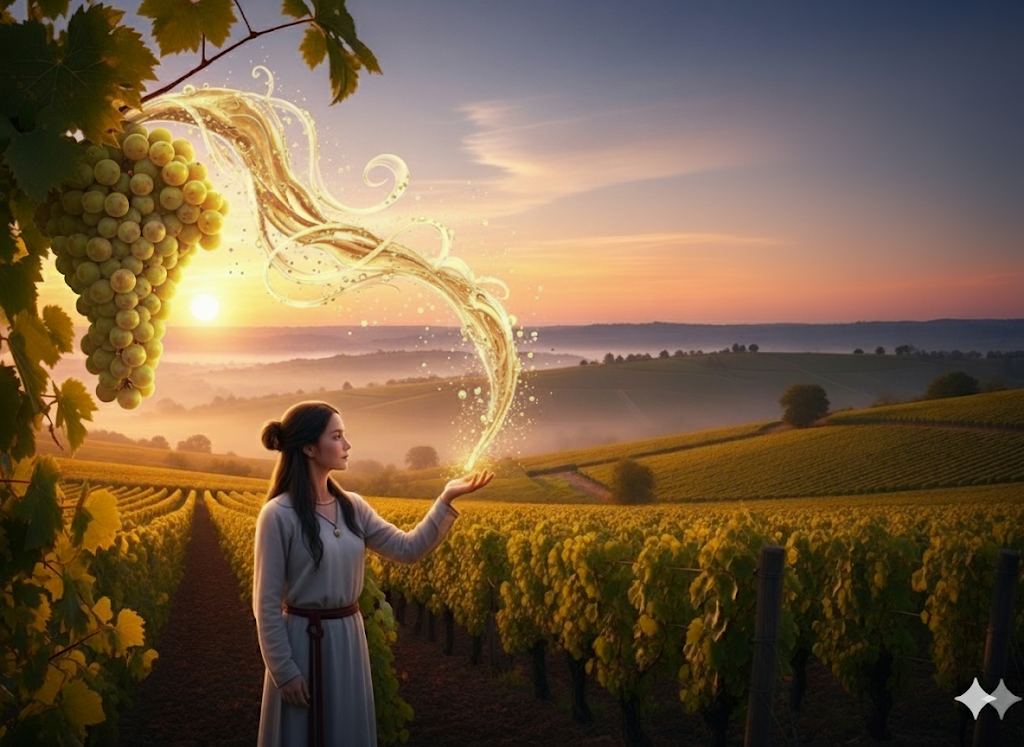Chassagne-Montrachet: Burgundy’s Pulse of Chardonnay Grace
Explore Chassagne‑Montrachet through Chang’e’s lyrical lens: from chestnut past to biodynamic future, taste Chardonnay’s mineral poise, Pinot’s quiet grace, and the cellar alchemy that turns scarcity into cultural treasure.

When Limestone Dreams at Dusk
Evening in the Côte de Beaune arrives like silk drawn over quiet strings, and in the hush between Puligny’s reverence and Santenay’s sigh, Chassagne‑Montrachet exhales a history thick with stone and longing. Lantern light paints the low walls—calcified whispers of the Jurassic sea—while vines, aligned like verses, lean into the breeze as if to catch an ancestral tale before it vanishes. This village, barely a flicker on a modern map, is a steady drumbeat in Burgundy’s pulse: a place where Chardonnay tightens like a drawn bow and Pinot Noir moves through shadow, soft as a cello.
Tonight, we descend the hillside not as tourists but as confidants, ready to translate centuries of marl and toil into liquid memory. Stand here long enough and you can taste the tension—a mineral hum beneath orchard breath, a low red murmur just below the white song. Chassagne is a duet of restraint and release, and every glass is both an invitation and a promise.
Of Chestnuts, Wars, and Quiet Revolutions
Before vine, chestnut; before commerce, monastery. Cassaneas, the ninth‑century record reads, was a place of nut groves and Roman tracks. The monks of Cîteaux arrived with scripture in one hand and Pinot cuttings in the other, carving terraces that still hold morning light like votive candles. For nearly a thousand years, red wine coursed through Chassagne’s cellars, coloring chalices on altars and tables alike. Only in the twentieth century did Chardonnay stride to the fore, a transformation slow as moss yet decisive as a bell‑tower chime.
The land knew violence: phylloxera’s root‑gnawing siege, two world wars that emptied barrels and households, the lean Depression winters when vignerons bottled courage more than profit. Families such as the Ramonets sold hope from horse carts, coaxing loyalty that today echoes in auction rooms and whispered allocations. The village grafted “Montrachet” to its name in 1879, not vanity but vocation—a pledge to the limestone crown rising above. Through plague and politics, the vines endured, mapping resilience onto every vintage like rings inside oak.
Limestone Lullabies and the Climate’s Pulse
Unfurl a map and see the hillside tilting east, a chin lifted to dawn. Altitudes ripple from 220 to 340 meters, and with each stride the soil shifts: up high, pale limestone fractured into shards that gleam like moon slivers; mid‑slope, powdery marl that smells of rain on chalkboard; lower down, clay thick as beaten chocolate where roots burrow for solace when summer scalds. The geology is neither background nor stage—it is score, tempo, and timbre.
Winds sweep from the Saône plain, cooling fruit that has basked all afternoon, etching acidity into flesh like calligrapher’s ink into vellum. Rain falls in measured stanzas, though hail sometimes scribbles chaos across the canopy. Yet even the storms become part of the cadence: hardship folded into character, crackle into grace. Each sunrise resets the metronome, and the vines begin again their slow choreography of sugar and pulse.
Vines Tended as Family Heirlooms
In Chassagne, viticulture is less a profession than custodianship, a generational relay where pruning shears might outlast family surnames. Dense plantings compel roots to duel, driving them deep through limestone veins until they sip water older than empire. The canopy is hedged by hand, leaf by leaf, so light dapples clusters rather than scalds them. Organic and biodynamic practices flourish not as manifesto but as intuition—cover crops hum underfoot, and barrels are racked in tune with lunar breath.
Low yields are accepted like wrinkles on a beloved face: proof of years, guarantor of nuance. Harvest begins at dawn; baskets fill with berries cool as river stones. The secateur’s clip is rhythmic, meditative, the heartbeat of September. Across the village, cousins trade pickers, friends trade sandwiches, and everyone trades weather notes. By dusk the presses groan, and juice—clear or tinted like sunset—flows into waiting cuves where silence thickens into anticipation.
Two Voices, One Throat—Chardonnay and Pinot Speak
Listen first to Chardonnay: a high note suspended over limestone percussion, tension wrapped in citrus zest and white blossom. Young, it pricks the tongue like sea spray; with time, it folds into hawthorn, quince, a faint edge of beeswax. Oak accents rather than adorns, adding a bass line of smoke and nutmeg that never outshouts stone.
Then lean toward Pinot Noir: quieter now, its acreage gradually ceded to the white wave yet still eloquent. It begins with small red berries—currant, wild strawberry—then lengthens into rose petal, iron, and forest after rain. The tannins are silk stitched with thread; structure present, never domineering. Pinot here is a letter slipped under the door: intimate, patient, rewarding only if one stops to read.
Cellars as Echo Chambers of Terroir
Experience has taught Chassagne’s vignerons that cellar choices can either amplify or muffle the hillside’s murmur. Pierre‑Yves Colin‑Morey leans into tension, fermenting in lightly toasted barrels, guarding reduction the way a sculptor guards un‑struck marble, then granting air at the precise moment fragrance unfurls. The Ramonet clan favors native yeasts and longer élevage, letting lees cradle wine like down comforter through winter’s lull. Morey‑Coffinet experiments with foudres and terra‑cotta eggs, believing the vessel’s shape can translate mineral cadence into silk.
Across these caves, humidity hovers, light stays dim, and a faint odor of mushroom and flint saturates stone walls. Barrels lie cheek‑to‑cheek like monks in silent prayer; each bung whispers carbon dioxide, a lullaby of fermentation. Time moves differently here: a month might feel like a sigh, a year like an exhaled paragraph. The winemaker listens, intervenes sparingly, decants fate into slight adjustments of rack and batonnage.
Names that Rise Like Smoke from Chimneys
Stroll the village at dawn and you might catch Jean‑Claude Ramonet rinsing glasses that have known four generations of vintages, the clink echoing down the cobblestones. A street over, Pierre‑Yves Colin‑Morey tastes from Pipettes, his face part concentration, part moonlight reflecting on barrel hoops. Near the church, Thibault Morey brushes moss from courtyard stones, explaining how biodynamics is less rulebook than stethoscope pressed to earth’s chest.
Michel Niellon, apron dusted with barrel dust, still marvels when a young Les Chaumées flashes citrus like fractured mica. Hubert Lamy cycles through town, mud spattering spokes, speaking of slope orientation as if it were family gossip. Each domaine is a verse in Chassagne’s living poem—independent yet inseparable, a collective memoir etched into cork and glass.
Time’s Patience—Cellaring and the Ritual of Pouring
Young Chassagne whites often taste like struck flint and green pear, taut as violin strings freshly tuned. Grant them five to seven years in a dark, steady 13 °C cellar and they relax into acacia, preserved lemon, and a saline crescendo that lingers after speech falters. Premier Cru parcels—Caillerets, Les Grandes Ruchottes—can hold conversation for two decades, trading their bright consonants for deeper vowels of truffle and hazelnut.
The reds, delicate of tannin, reach prime a shade sooner, yet the best will unfurl for fifteen years, morphing from cherry skin to dried rose, from forest floor to soft spice. Pour whites just below cellar temperature—about 12 °C—to catch the first floral whisper; if reduction clouds the glass, a brief decant releases it like dawn diffusing mist. Reds prefer 15–16 °C and a wide‑bellied bowl where their quiet complexity can unfurl. Pair with roast poularde flecked with thyme, or sautéed chanterelles on buttered brioche. Salt and fat weave together the wine’s tensile minerality and the dish’s comfort.
Investing in Cultural Memory, Not Just Margin
Speculation follows scarcity the way shadow follows light, and Chassagne offers both in measured tension. Parcels seldom span more than a few rows; some are no larger than a herb garden. Climate change trims yields further, and hail can erase a vintage in twenty minutes, turning each surviving cluster into a minor miracle. Collectors sense this fragility and pursue allocations with near‑religious fervor. Yet dollars and euros are only arithmetic; the true gain is experiential equity.
To purchase a young Chassagne is to buy unfinished music, to own a manuscript whose ink dries slowly across decades. Tracking its evolution teaches palate, patience, and humility; it threads moments of one’s life—birthdays, farewells—into the wine’s expanding narrative. Markets rise, dip, correct; limestone remains unmoved, and tradition keeps its quiet ledger beyond price.
Where Stone, Story, and Silence Converge
Chassagne‑Montrachet stands as palimpsest: Roman road beneath cloister hymn beneath the hum of modern tractors. White and red continue their contrapuntal dance, limestone and clay debate politely below, and every barrel holds both secret and confession. To drink Chassagne is to taste a village thinking aloud—sometimes melancholic, often exultant, always reflective. These wines are not merely beverages; they are weathered diaries written in acid and tannin, signed by stone, co‑authored by time.
Watch the valley at twilight: swallows stitch dusk to hill, the vines exhale, and the moon—Chang’e’s ancient sphere—rides silent above. In that soft silver, Chardonnay and Pinot seem almost to glitter, and we are reminded that soil remembers what the mind forgets. Lift the glass; let the village speak.





